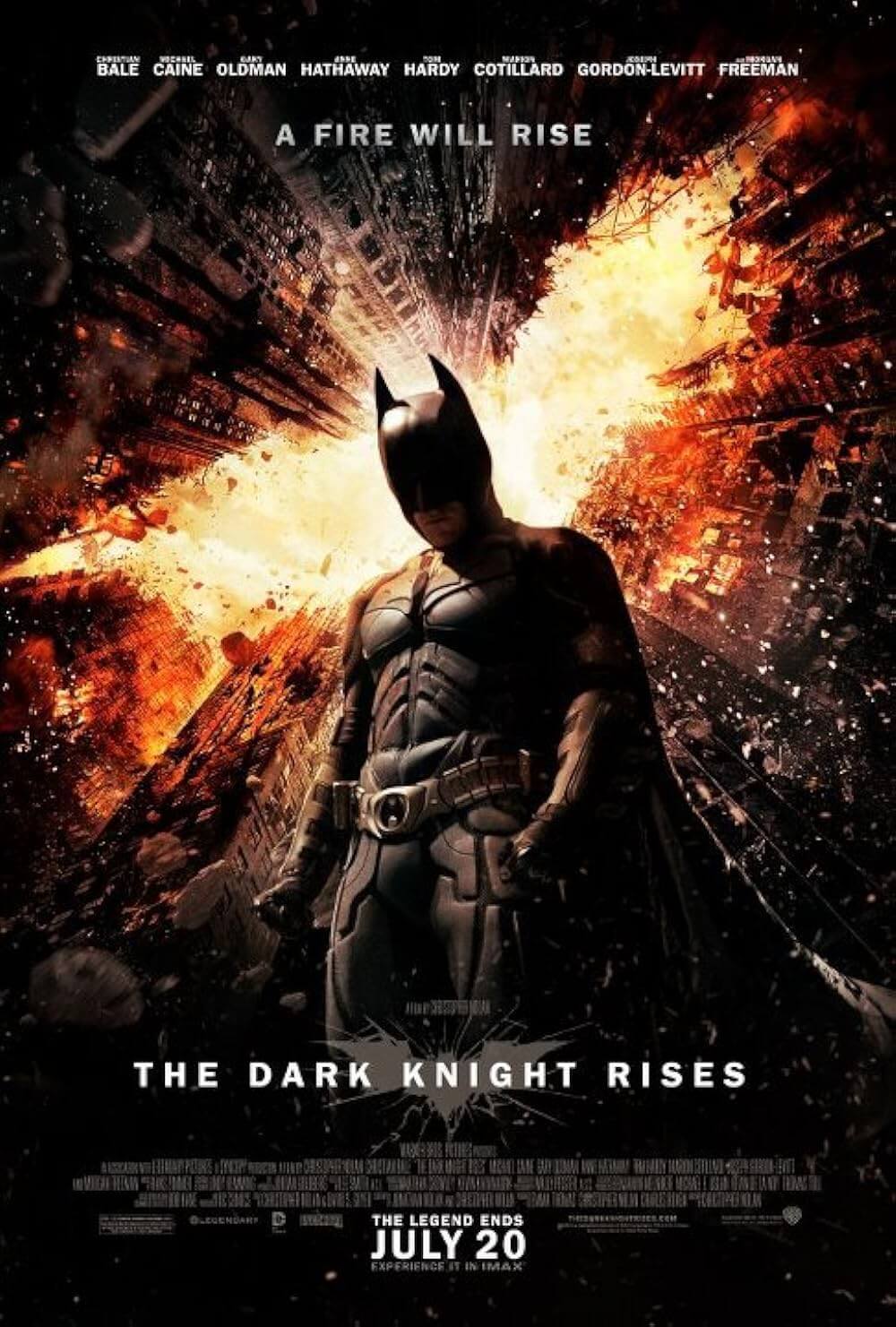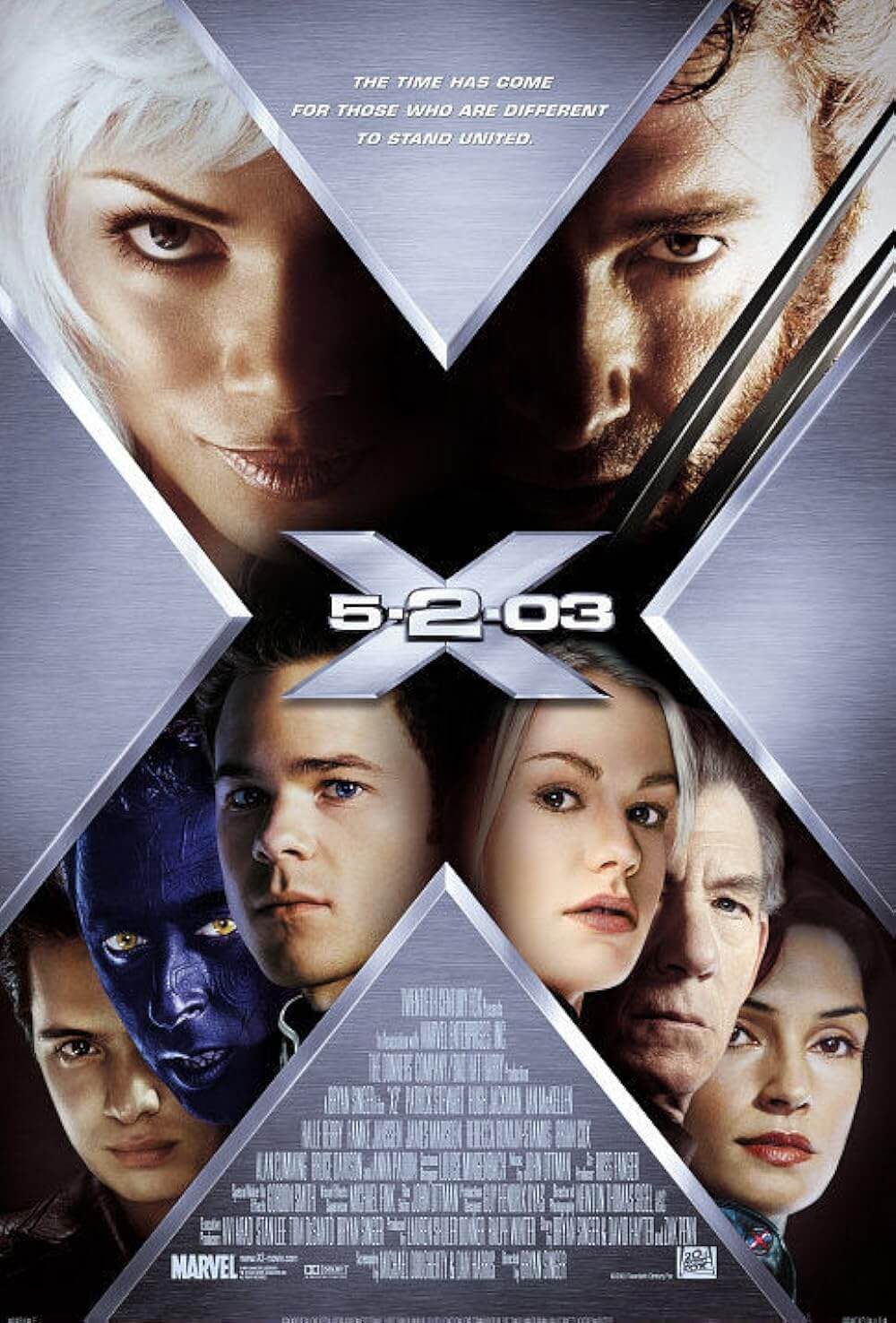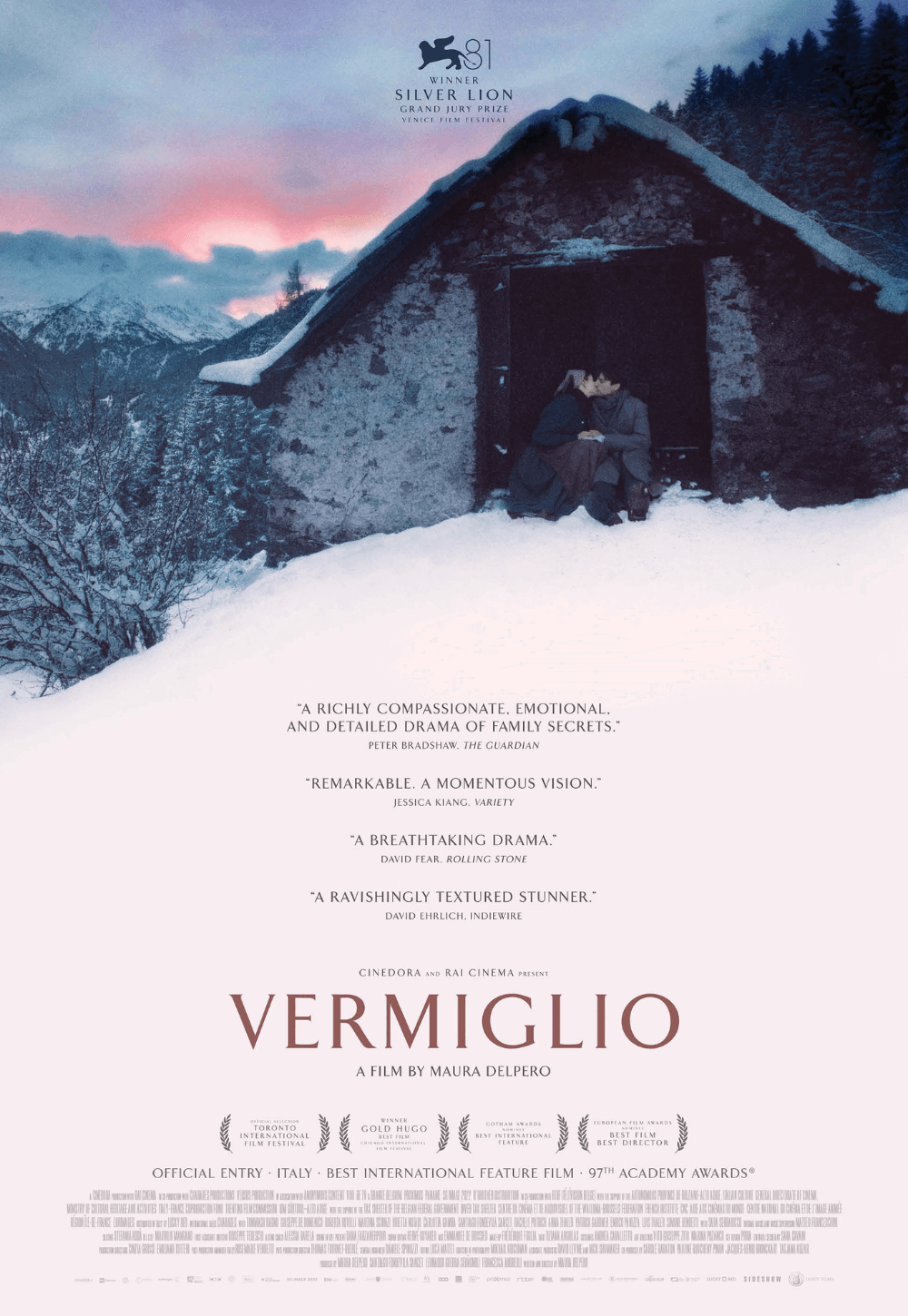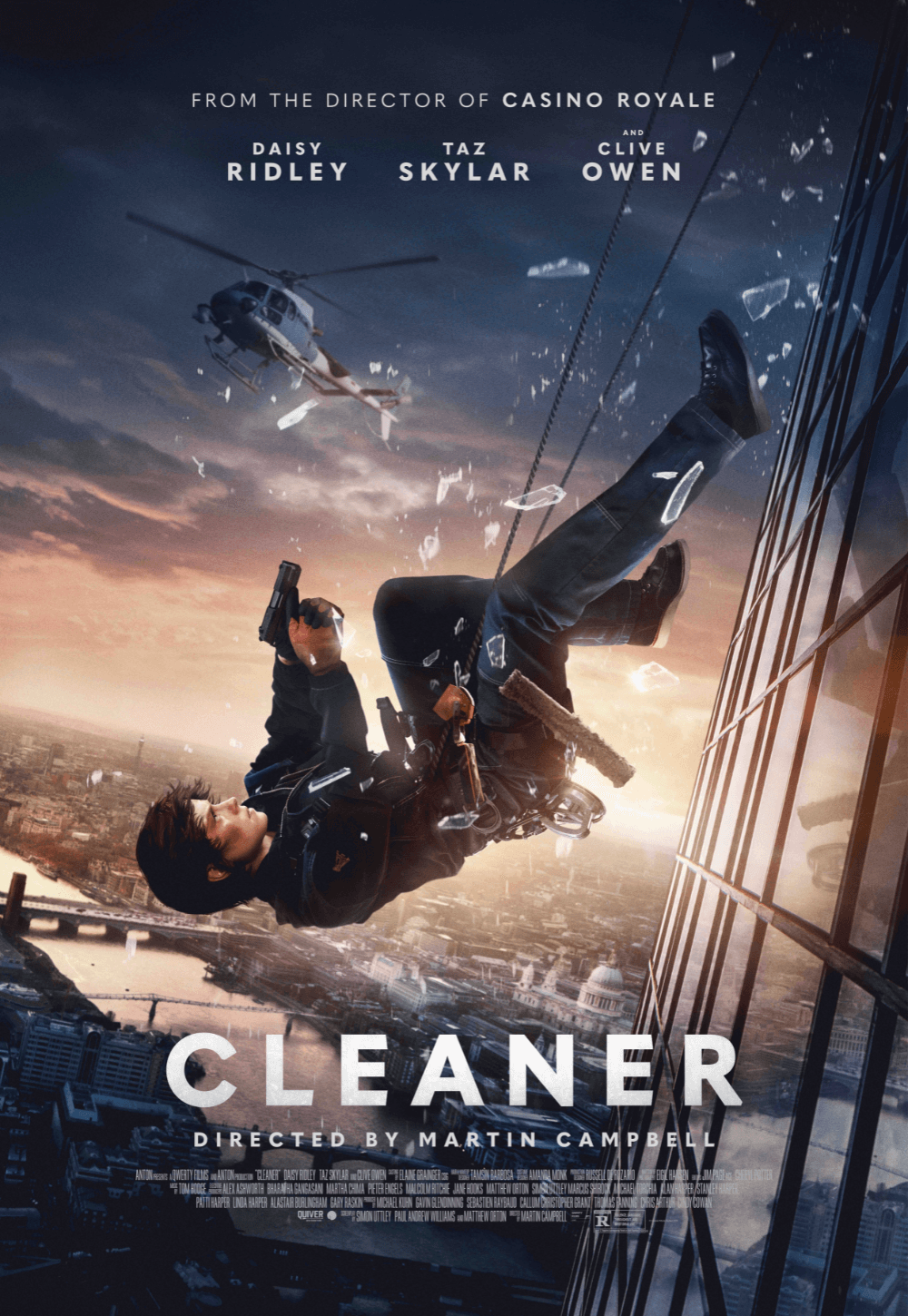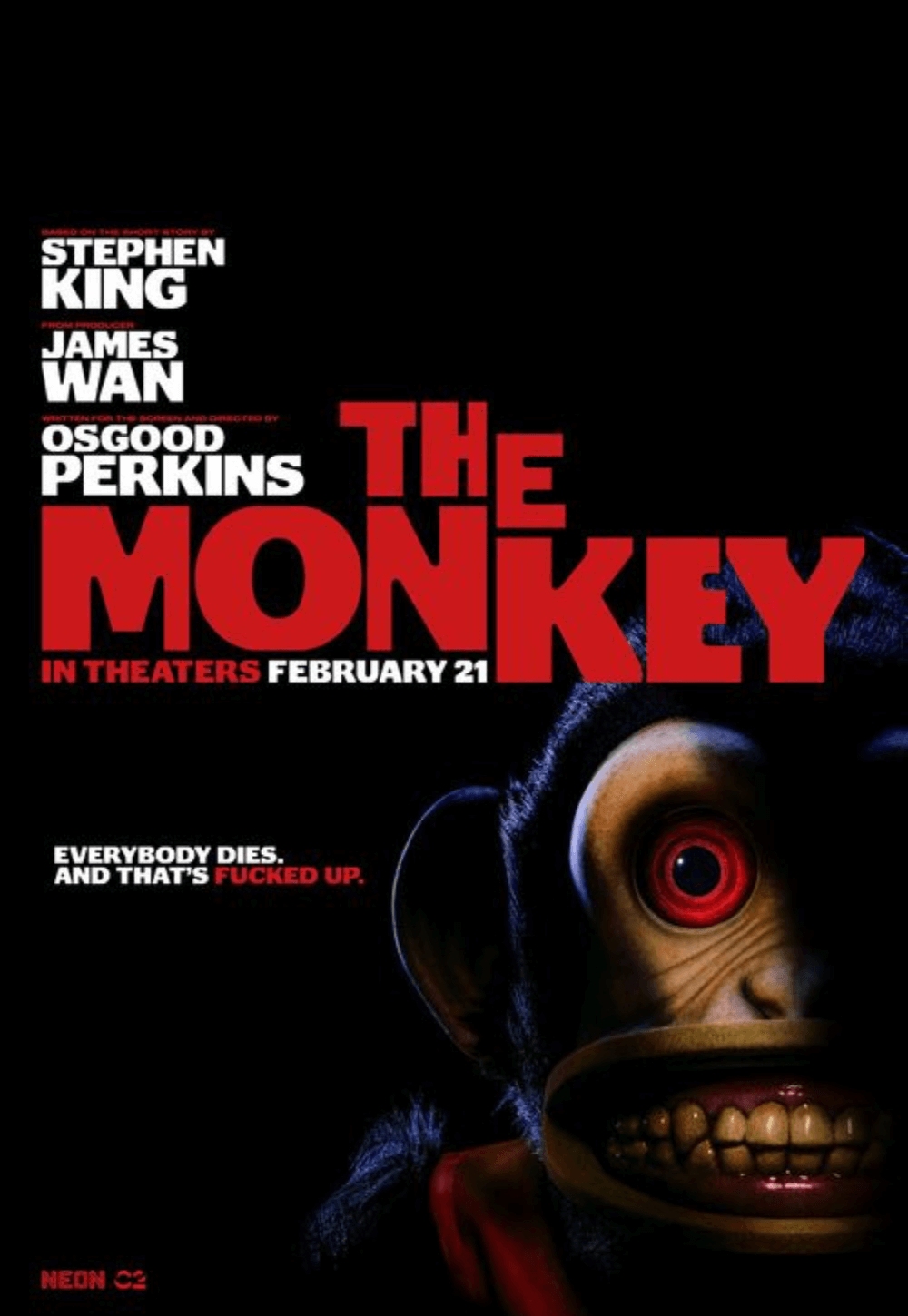The Definitives
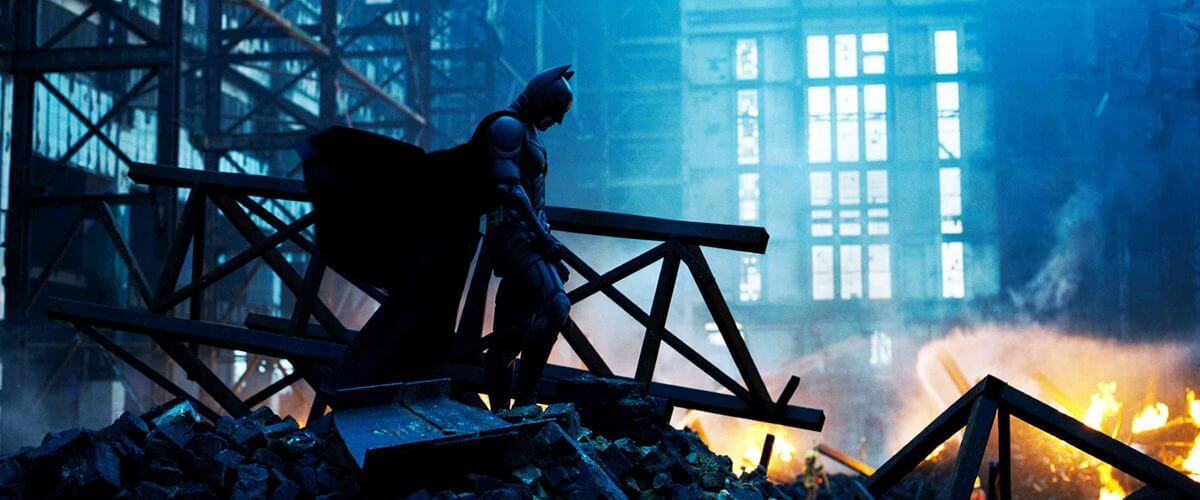
The Dark Knight
Essay by Brian Eggert |
“As a man, I’m flesh and blood. I can be ignored. I can be destroyed. But as a symbol… As a symbol, I can be incorruptible.” Spoken by Bruce Wayne as he mulled over how to become a symbol for Gotham City’s citizens so plagued by corruption and crime, these lines from Batman Begins are put to the test in its sequel, The Dark Knight, an incomparable crime thriller and superhero film, and an instant classic in both genres. The picture explores the notion of a White Knight—not a hero in the cape and cowl sense, but a person—who replaces the need for Batman, and how such an idea remains impossible. Director Christopher Nolan employs grand symbolic narrative turns to investigate the need for heroes in our culture, but more importantly heroes who cannot be compromised. What the rapt audience, and ultimately a disenchanted Batman, discovers by the film’s grave conclusion is that Wayne’s original forethought was accurate. People are corruptible, but the power of a symbol is that it remains unwavering no matter what trials it must endure. It is this resolve that makes the symbol a fixed icon, and it is a lesson learned through appalling tragedy.
If Batman Begins is the launching pad for serious comic book-to-film adaptations, The Dark Knight is the definitive destination, a place where the hero broods on his perch and the villains are either described without a modicum of sympathy, or they were once heroes who in time become twisted into killers. The second chapter in Nolan’s restorative treatment of the DC Comics legend, the film embeds symbolic drama worthy of Greek tragedy into an erupting crime story, tinged with a burning shower of distrust toward the absoluteness and simplicity of good and evil. Just as he did in 2005 with the film’s predecessor, Nolan elevates comic book’s myth beyond mere pop-culture entertainment and laces his material with a dark poetry of shattered identities and the frightening truths of an emblematic hero’s responsibility. Removed from the wholly psychological conflict of Batman Begins, brothers and co-writers Christopher and Jonathan Nolan have decorated each stirring moment of this sequel with external threats far more challenging than the previous film. Bombarded by a threat in whom he cannot provoke fear, Batman’s conflict is embedded in his resolve to provide Gotham City with a symbol of hope, no matter the cost.
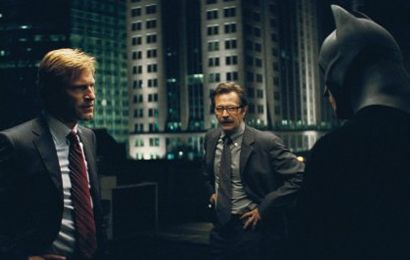 Nolan opens his film with a bank heist, a sequence consciously inspired by Michael Mann’s Heat. Clown-masked hoods steal bags of cash from a mob bank, and the plan’s orchestrator, killing his lackeys one-by-one as they complete their duties in the score, drives away with the loot all to himself. Personifying sheer bedlam is The Joker, who, given a brilliant splattering of unhinged madness by the late Heath Ledger, epitomizes Gotham City’s need for a hero and their desire for someone to believe in. Neither trouncing of fear nor overcoming of guilt can defeat this “mad-dog” of anarchy, armed with little more than gasoline, gunpowder, knives, and the aggressive wit to use them. The Joker has emerged because Gotham’s organized crimelords have gone underground, afraid to make a move with Batman on the prowl. And then there’s the new district attorney, Gotham City’s “White Knight” Harvey Dent (Aaron Eckhart). Dent makes aggressive moves against otherwise untouchable mob bosses like Salvatore Maroni (Eric Roberts), convincing his fellow citizens that a change can and should be made in Gotham. His campaign slogan “I Believe in Harvey Dent” suggests that the city may someday no longer need their Caped Crusader.
Nolan opens his film with a bank heist, a sequence consciously inspired by Michael Mann’s Heat. Clown-masked hoods steal bags of cash from a mob bank, and the plan’s orchestrator, killing his lackeys one-by-one as they complete their duties in the score, drives away with the loot all to himself. Personifying sheer bedlam is The Joker, who, given a brilliant splattering of unhinged madness by the late Heath Ledger, epitomizes Gotham City’s need for a hero and their desire for someone to believe in. Neither trouncing of fear nor overcoming of guilt can defeat this “mad-dog” of anarchy, armed with little more than gasoline, gunpowder, knives, and the aggressive wit to use them. The Joker has emerged because Gotham’s organized crimelords have gone underground, afraid to make a move with Batman on the prowl. And then there’s the new district attorney, Gotham City’s “White Knight” Harvey Dent (Aaron Eckhart). Dent makes aggressive moves against otherwise untouchable mob bosses like Salvatore Maroni (Eric Roberts), convincing his fellow citizens that a change can and should be made in Gotham. His campaign slogan “I Believe in Harvey Dent” suggests that the city may someday no longer need their Caped Crusader.
And so, Dent is the personal symbol of hope for Bruce Wayne (Christian Bale): he provides a face for justice where Batman’s masked façade cannot go, a beacon for the potential good in the common man, and a possible end point for the necessity of Batman. Indeed, being Batman is not a job Wayne wants; rather it is something he must do. He has created a “monster” inside himself to fight injustice, and in doing so sacrificed his former love Rachel Dawes (Maggie Gyllenhaal), who now, too, believes in Harvey Dent. Batman has learned that symbols can be dangerous. Devoted followers in the form of would-be vigilantes in copycat Batman garb run about the city; they have the look, but not the talent, carrying guns and getting themselves mowed down by the experienced criminal element of Gotham. To support the promise of Dent’s reputation, Wayne uses his influence to ensure Dent a long career, while Batman teams with both Dent and Lieutenant Gordon (Gary Oldman) to strike organized crime where it hurts: their money, laundered internationally by Chinese businessman Lau (Chin Han). Lau may be out of Gordon and Dent’s jurisdiction, but not Batman’s. Once they secure Lau, they cut off the mob’s money and secure countless indictments.
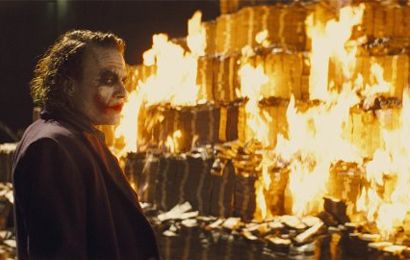 Meanwhile, breathing bloody and unbalanced fear into everyone around him, The Joker terrifies even the crimelords, who agree to pay him half of their reserves for Batman’s head. But this is not merely a transaction for The Joker. He recognizes the power of Batman as a symbol. He understands that should his symbol cease to be, it would no longer have power over Gotham City’s criminal element, which, in his absence, could once again take control of the metropolis. He seems to have constructed himself as an opposing symbol to Batman’s; etched into the character’s face are scars of a permanent smile. He tells one victim his abusive father did it, another he did it to himself, and no doubt has other explanations. But the origin of The Joker remains unimportant, since he exists as a force of Nature, and with every heavy, licking breath and hideous cackle exudes terror. In symbolic terms, he represents the potential for human evils, wearing a messy greasepaint mask as a living design of frenzied masochism. He also represents the antithesis of Batman, who despite (albeit shoddy and unwelcome) copycats, carries on as a symbol of hope. The Joker is pure anarchy and orchestrates his influence over Gotham, testing the limits of human savagery through a sadistic terror campaign that demands common citizens become murders. He publically promises daily killings unless Batman reveals his identity to the world, knowing Batman would be powerless if he ceased to be a symbol.
Meanwhile, breathing bloody and unbalanced fear into everyone around him, The Joker terrifies even the crimelords, who agree to pay him half of their reserves for Batman’s head. But this is not merely a transaction for The Joker. He recognizes the power of Batman as a symbol. He understands that should his symbol cease to be, it would no longer have power over Gotham City’s criminal element, which, in his absence, could once again take control of the metropolis. He seems to have constructed himself as an opposing symbol to Batman’s; etched into the character’s face are scars of a permanent smile. He tells one victim his abusive father did it, another he did it to himself, and no doubt has other explanations. But the origin of The Joker remains unimportant, since he exists as a force of Nature, and with every heavy, licking breath and hideous cackle exudes terror. In symbolic terms, he represents the potential for human evils, wearing a messy greasepaint mask as a living design of frenzied masochism. He also represents the antithesis of Batman, who despite (albeit shoddy and unwelcome) copycats, carries on as a symbol of hope. The Joker is pure anarchy and orchestrates his influence over Gotham, testing the limits of human savagery through a sadistic terror campaign that demands common citizens become murders. He publically promises daily killings unless Batman reveals his identity to the world, knowing Batman would be powerless if he ceased to be a symbol.
When he learns that Batman will not bend no matter how many innocents die, The Joker gets the last laugh when he transforms Gotham’s “true hero” into a vengeful killer. As Gotham’s White Knight, Dent, a tangible and human figure, has the potential to reform the city into a place no longer characterized by crime. Already his influence is apparent: Gotham has transformed from the grimy, squalid brown-tone sprawl of Batman Begins into an urban environment of clean city streets, bright skies, and hope. Unfortunately for Gotham, and for Wayne, who places so much optimism in Dent, their District Attorney is just a man. Realizing that humanness will not sway the tides of Gotham, no matter how much Dent is aggrandized, becomes Batman’s harsh insight. When The Joker proves Dent susceptible by killing his would-be fiancé Rachel Dawes, he transforms the heroic public servant into the horribly scarred and vengeful Two-Face, and in turn births a living representation of the uncertain duality in all people—how they turn with the flip of a coin depending on chance and circumstance. The entire city teeter-totters between good and evil, masses driven to commotion by whoever pulls their strings, signifying the limitations of people and their need for someone to guide them: resolute heroes like Batman.
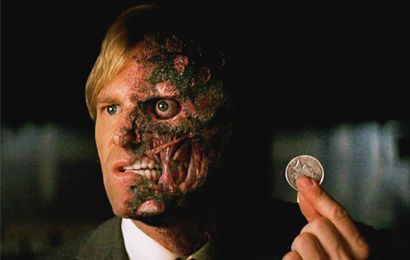 After The Joker’s warped plot to turn everyday citizens into murderers fails, he is captured by Batman, who then rushes off to witness his own personal hope for change lost on the vulnerabilities of flesh and blood. Two-Face blames a corrupt police force for the death of Rachel, and has taken revenge on those he deems responsible. Now his gun points at Jim Gordon and his family. In this tragic exchange, Dent sits at the human center of the iconic clash between the established hero Batman and decisive villain The Joker. Stricken with the potential for either law-abiding heroics or murderous rage, as Two-Face he stands for the whole of Gotham City. And therein dwells the poetry of Nolan’s narrative—that hero and villain vie for the soul of one man, whose presence as savior is seemingly representative of an entire city’s fate. Indeed, the duality of the core subject tears at the seams, strengthening the significance of the symbolic (and exciting) battle at the film’s forefront. But in stopping the corrupted Two-Face, Batman kills Dent and tragically destroys Gotham’s hope for a powerful human symbol. It is only by hiding how The Joker manipulated Dent into a killer and accepting the blame for Dent’s death that Batman becomes another kind of hero entirely: The Dark Knight of Gotham City, whose heroics require only that he supplies what the people of Gotham need, be it a hero or scapegoat.
After The Joker’s warped plot to turn everyday citizens into murderers fails, he is captured by Batman, who then rushes off to witness his own personal hope for change lost on the vulnerabilities of flesh and blood. Two-Face blames a corrupt police force for the death of Rachel, and has taken revenge on those he deems responsible. Now his gun points at Jim Gordon and his family. In this tragic exchange, Dent sits at the human center of the iconic clash between the established hero Batman and decisive villain The Joker. Stricken with the potential for either law-abiding heroics or murderous rage, as Two-Face he stands for the whole of Gotham City. And therein dwells the poetry of Nolan’s narrative—that hero and villain vie for the soul of one man, whose presence as savior is seemingly representative of an entire city’s fate. Indeed, the duality of the core subject tears at the seams, strengthening the significance of the symbolic (and exciting) battle at the film’s forefront. But in stopping the corrupted Two-Face, Batman kills Dent and tragically destroys Gotham’s hope for a powerful human symbol. It is only by hiding how The Joker manipulated Dent into a killer and accepting the blame for Dent’s death that Batman becomes another kind of hero entirely: The Dark Knight of Gotham City, whose heroics require only that he supplies what the people of Gotham need, be it a hero or scapegoat.
Each of Nolan’s films explores a split in the psyche of his protagonist(s), externalized in the outward narrative and ultimately an influence on the film’s formal presentation. And so, Batman’s superhero/alter-ego dynamic, The Joker’s antithetical posture against Batman, and Harvey Dent’s eventual split each fit nicely into the director’s exploration of divided characters: Nolan’s masterful debut Memento is bisected between forward- and backward-moving temporalities, between the protagonist’s unknowing short-term memory loss and his self-deception to keep himself advancing, regardless if perceived forward motion actually takes him backward. Insomnia presents an amoral detective’s pursuit of a killer, his sleeplessness provoked by his guilt because he too is a murderer. The Prestige involves two magicians attempting to achieve the same teleportation illusion using doubles, either by a look-alike or by recreating oneself through scientific manipulation; the film meditates closely on the duality of the performer and his personal life, and how one must sacrifice the other to thrive. Batman’s duality, his distinction between and eventual separation of personas, aligns with Nolan’s ongoing pursuit of internal duality conflicts by manifesting it in physical vocabulary.
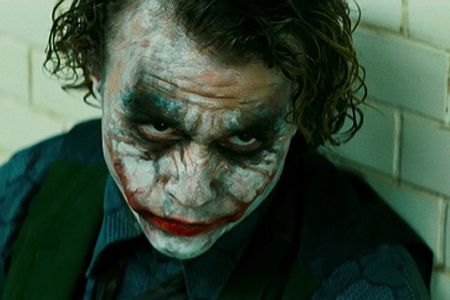 Tantamount to Nolan’s fondness for symbolism is his grandiosity and showmanship; this balance between artistry and entertainment has solidified him as one of the great filmmakers of his day. From elaborate car chases to high-wire stunts to unexpected twists throughout, The Dark Knight’s thrills are extraordinary. In one sequence, he flips a semi-truck and trailer into the air and onto its back; in another, his cinematographer Wally Pfister shoots Hong Kong high-rises with an awe-inspiring majesty. During the film, Batman re-tailors the long-standing rigidity of his costume into one capable of fluid movement, bringing new mobile life to his fight scenes. All the while, Nolan permeates a plot that moves urgently, keeping up with the pace established by The Joker from the outset. Despite the impressive treatment of the action sequences, smaller, close-quarter scenes remain fascinating for the performances involved, since this is a film about individuals battling for larger, figurative stakes. Ledger gets face-to-face with his character’s enemies, spewing out nasty rants, matching his words only by his skilled ability to disturb us with a palpable sense of alarm. Never has a comic book material gripped the viewer so in equal levels of raw entertainment, involvement in the plot, and emotional significance. But as much as Christopher and Jonathan Nolan put into the intricate storytelling, the production has no end of spectacles to behold.
Tantamount to Nolan’s fondness for symbolism is his grandiosity and showmanship; this balance between artistry and entertainment has solidified him as one of the great filmmakers of his day. From elaborate car chases to high-wire stunts to unexpected twists throughout, The Dark Knight’s thrills are extraordinary. In one sequence, he flips a semi-truck and trailer into the air and onto its back; in another, his cinematographer Wally Pfister shoots Hong Kong high-rises with an awe-inspiring majesty. During the film, Batman re-tailors the long-standing rigidity of his costume into one capable of fluid movement, bringing new mobile life to his fight scenes. All the while, Nolan permeates a plot that moves urgently, keeping up with the pace established by The Joker from the outset. Despite the impressive treatment of the action sequences, smaller, close-quarter scenes remain fascinating for the performances involved, since this is a film about individuals battling for larger, figurative stakes. Ledger gets face-to-face with his character’s enemies, spewing out nasty rants, matching his words only by his skilled ability to disturb us with a palpable sense of alarm. Never has a comic book material gripped the viewer so in equal levels of raw entertainment, involvement in the plot, and emotional significance. But as much as Christopher and Jonathan Nolan put into the intricate storytelling, the production has no end of spectacles to behold.
Among them are the characters in The Dark Knight, how their dimensionality is only matched by the layered performances of the actors playing them. Bale’s Batman comes with a serrated voice cutting through any chance for campy banter, any sense of charm; instead, he evokes that horribly surreal sense of other-worldliness, startling and appropriately intimidating. Whereas Batman’s philosophy of striking fear into the hearts of Gotham’s criminals seems a joke with Michael Keaton, Val Kilmer, or George Clooney, there is no doubt Bale’s menacing portrayal would do just that. And yet, while his onscreen intensity perfectly captures the monstrous Batman lurking inside Bruce Wayne, Bale exceeds at accomplishing those lighthearted moments of Wayne’s playboy buffoonery, essential to the character’s duality, not to mention keeping suspicions linking the two at bay—something the other Batman films forgot altogether. The film’s best performance, however, comes from Ledger, who gives his most textured, disturbing, and kinetic portrayal. Here we see the zenith of his talents. Forget the near-slapstick interpretation by Cesar Romero and the over-the-top showmanship by Jack Nicholson; Ledger offers a wild, animalistic depiction of the Joker that inspires genuine fright. The brothers Nolan succeed in writing a villain worthy of their Batman’s iconography, without reducing the figure to gimmicky devices. From his character’s pointedly shocking entrance into the criminal underworld to his meticulous, seemingly out-of-control plans to spread pandemonium, Ledger evokes greatness, making his penultimate performance the stuff of screen legend.
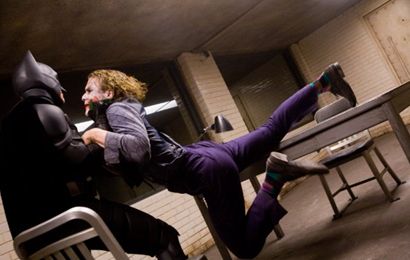 Nolan dons his picture with an appropriately shadowy look; although, less stylized visually than the first, The Dark Knight does not placate itself as a sequel, nor even as a superhero film. His Gotham City is not the gothic paradise of the comic book, rather just a city, occasionally filled with daylight, familiar architecture, and masses swayed by the temptations of The Joker and the example set by Batman and Dent. His themes unfurl not like a comic book story, but like an epic crime saga from Mann, DePalma, or Coppola. The film subsists as its own adroit personality, complete with a Batman-less title and actors delivering performances of the highest caliber, moving further into the realm of dramatic, actionized storytelling, versus a reliance on obvious comic book archetypes. Its accessibility through the iconic matchup of Batman and The Joker, adjoined by Nolan’s purely cinematic action sequences, and the regrettable but highly publicized death of Ledger, resulted in a massive showing upon the film’s initial release. It would go on to earn more than $530 million in domestic receipts alone, become the second most successful film ever made at the time of its release, and establish itself as the apex of superhero filmmaking.
Nolan dons his picture with an appropriately shadowy look; although, less stylized visually than the first, The Dark Knight does not placate itself as a sequel, nor even as a superhero film. His Gotham City is not the gothic paradise of the comic book, rather just a city, occasionally filled with daylight, familiar architecture, and masses swayed by the temptations of The Joker and the example set by Batman and Dent. His themes unfurl not like a comic book story, but like an epic crime saga from Mann, DePalma, or Coppola. The film subsists as its own adroit personality, complete with a Batman-less title and actors delivering performances of the highest caliber, moving further into the realm of dramatic, actionized storytelling, versus a reliance on obvious comic book archetypes. Its accessibility through the iconic matchup of Batman and The Joker, adjoined by Nolan’s purely cinematic action sequences, and the regrettable but highly publicized death of Ledger, resulted in a massive showing upon the film’s initial release. It would go on to earn more than $530 million in domestic receipts alone, become the second most successful film ever made at the time of its release, and establish itself as the apex of superhero filmmaking.
The debate about what it means to be a hero, one heavily discussed in comic books, is timeless, stemming back to Gilgamesh and Achilles—figures either altogether fictional or first written about hundreds of years after their supposed existence. Their stories have been passed down and retold over the ages, and the mythology changes to fit the storyteller’s pretense. They are reexamined again and again to penetrate our understanding of the hero’s inner conflict. Heroes and villains epitomize the basic roots of storytelling, providing evident boundaries and supplying the most apparent symbols of right and wrong. But ever since Homer’s Iliad split Achilles between his hunger for glory and his displeasure with Agamemnon’s selfish war, humans have been fascinated with the inner complexity of heroes, the flaws of mankind, and the power of symbols that endure no matter how intolerable the circumstances they face. In The Dark Knight, the Batman symbol established in Batman Begins transcends itself; the hero commits a truly selfless act for his city by turning Harvey Dent into a martyr at his own expense and accepts that being a symbol is about more than being a hero. Batman’s grip on Gotham slips under the brutal duress of The Joker, who incessantly tests the authority of Batman’s symbolic reach. But Batman’s devotion does not end at his enduring heroism; his commitment extends deep into self-sacrifice as he confirms his place as protector of Gotham City, not just from crime and villainy, but from the corruption of the spirit.
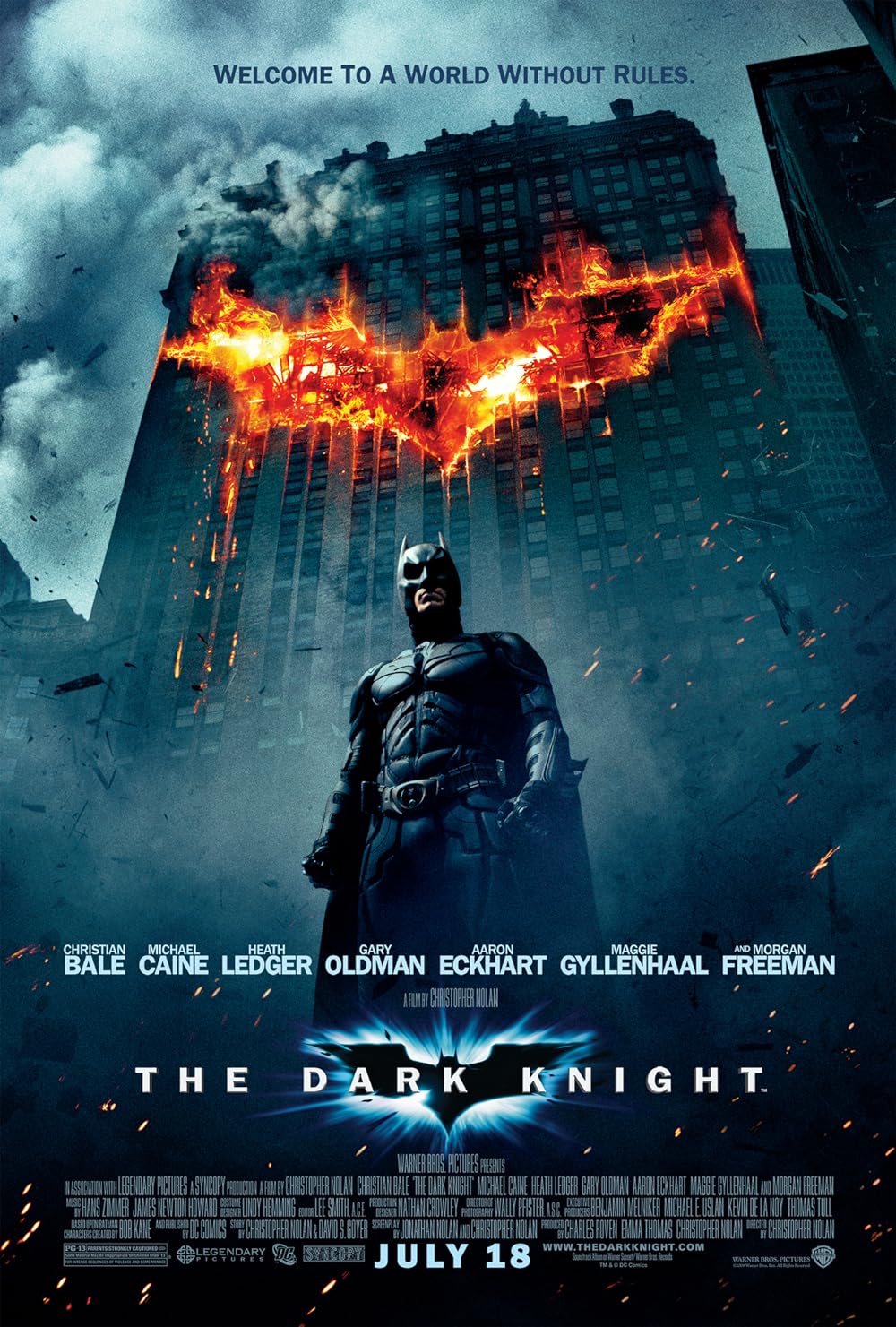
Consider Supporting Deep Focus Review
I hope you’re enjoying the independent film criticism on Deep Focus Review. Whether you’re a regular reader or just occasionally stop by, please consider supporting Deep Focus Review on Patreon or making a donation. Since 2007, my critical analysis and in-depth reviews have been free from outside influence. Becoming a Patron gives you access to exclusive reviews and essays before anyone else, and you’ll also be a member of a vibrant community of movie lovers. Plus, your contributions help me maintain the site, access research materials, and ensure Deep Focus Review keeps going strong.
If you enjoy my work, please consider joining me on Patreon or showing your support in other ways.
Thank you for your readership!
Brian Eggert | Critic, Founder
Deep Focus Review



